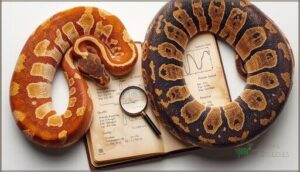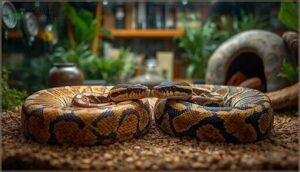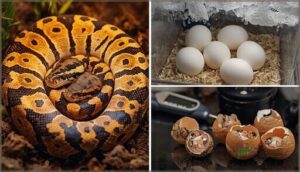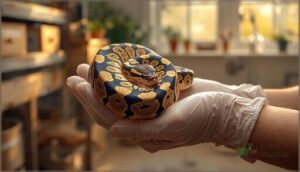This site is supported by our readers. We may earn a commission, at no cost to you, if you purchase through links.

You pair two ball pythons together, wait weeks for eggs, and then crack open the first hatchling to find… exactly what you planned. That’s the power of genetic breeding, where understanding inheritance patterns transforms random chance into calculated outcomes.
Dominant genes like Pinstripe show up in every pairing, while recessive traits like Albino hide for generations until two carriers meet. Co-dominant morphs create stunning super forms when doubled up, turning a single Mojave into a Blue-Eyed Leucistic.
Mastering these patterns means you’re not just hoping for desirable offspring—you’re engineering them through strategic pairings, proven genetics, and careful record-keeping. The difference between guesswork and precision comes down to understanding how traits pass from parent to hatchling.
Table Of Contents
Key Takeaways
- Ball python breeding transforms from guesswork into predictable outcomes when you master dominant, recessive, and co-dominant inheritance patterns—with Punnett squares revealing exact odds like 25% visual morphs from heterozygous recessive pairings.
- DNA testing and genetic calculators have revolutionized carrier identification and phenotype prediction, allowing breeders to confirm hidden recessive alleles and model outcomes across 400+ genes before ever introducing pairs.
- Breeding readiness demands females reach minimum 1,500 grams and 2-3 years while males need 700 grams and 12-18 months, with strict quarantine protocols (60-90 days) preventing disease outbreaks that have hit 94% in poorly managed collections.
- Ethical breeding prioritizes long-term animal welfare over market trends by avoiding morphs with neurological defects like Spider wobble syndrome, preventing overproduction in saturated markets, and maintaining transparent genetic health disclosures through documented bloodlines.
Key Genetics in Ball Python Breeding
Before you pair a single snake, you need to understand the genetic playbook that determines every color, pattern, and trait in your clutch.
Ball python breeding isn’t guesswork—it’s predictable science once you know how dominant, recessive, and co-dominant genes interact.
Let’s break down the essential genetics that’ll transform you from hobbyist to strategic breeder.
Dominant, Recessive, and Co-Dominant Traits
Breeding ball pythons hinges on three inheritance patterns that govern morph expression. Dominant traits, like Pinstripe, appear instantly with just one allele, showing consistent visual outcomes. Recessive traits require matching genes from both parents—breeding two heterozygous carriers gives you 25% visual morphs. Co-dominant genes deliver the sweet spot: single-gene morphs and striking super forms, making them breeding powerhouses for diverse outcomes.
Understanding breeding ball pythons requires knowledge of recessive, dominant, and co-dominant genetics.
Mendelian Inheritance and Punnett Squares
Your breeding predictions live or die by Mendelian inheritance principles. Punnett squares transform genetic inheritance from guesswork into numbers—heterozygous pairings for recessive traits yield 25% visuals, 50% carriers, exactly as predicted. Double recessives? You’re looking at 6.25% odds per egg.
Empirical outcomes across hundreds of clutches confirm these ratios hold true, though inheritance deviations occasionally surprise you when allelic complexity enters the picture.
Certain color morphs, like those affecting endothelin signaling, are linked to specific genetic variants.
Identifying Carriers and Visual Morphs
Once you understand the odds, you need to distinguish between visual morphs and hidden carriers—recessive genes don’t announce themselves. Genetic testing technologies have revolutionized carrier identification, replacing guesswork with DNA-based precision.
You can now detect carriers through:
- PCR-based assays targeting TYR gene mutations for Albino morphs
- OCA2 deletion testing for Lavender Albino carriers
- TYRP1 variant sequencing for Ultramel identification
- Shed skin sampling for noninvasive genotyping
- Machine learning tools achieving 98% accuracy on well-defined phenotypes
Visual identification works for dominant genes and obvious morphs, but carrier frequency in breeding stock runs surprisingly high—up to 32% in some collections carry hidden recessive alleles. Testing technologies continue advancing, though morph variability means fewer than twenty major morphs currently have reliable genetic markers. Your breeding strategies depend on knowing exactly what genetics you’re working with, not just what you see.
Polygenic Traits and Genetic Complexity
Not all traits follow simple genetic rules—polygenic traits arise from multiple genes acting together, creating a spectrum of phenotypes instead of predictable ratios. Pattern reduction, blushing intensity, and genetic striping are classic examples. You won’t see clear 1:1:1:1 ratios; instead, you’ll find variation within each clutch based on trait heritability and quantitative models.
Environmental influence can shift outcomes even among genetically similar siblings. Multigenerational selection becomes necessary because polygenic traits build incrementally across generations. Phenotype scoring helps track progress, but you’re refining genetic complexity, not flipping switches. Twin studies confirm strong genetic control, yet predicting exact outcomes remains challenging without rigorous record-keeping across bloodlines.
| Trait Type | Inheritance Pattern | Breeding Strategy |
|---|---|---|
| Pattern Reduction | Polygenic, gradual expression | Score phenotypes across 3-5 generations |
| Blushing Intensity | Multiple genes, environmental factors | Select top-tier individuals repeatedly |
| Genetic Striping | Quantitative models, additive effects | Maintain diverse bloodlines, track lineage |
| Clutch Size | High heritability, genetic correlation | Use longitudinal data for selection |
| Color Density | Polygenic with recessive trait interaction | Combine phenotype scoring with genetic diversity |
Successful polygenic breeding demands patience—you’re building genetic inheritance layer by layer, not banking on single-clutch wins.
Selecting and Pairing for Desired Traits
Once you understand the genetic foundations, the real work begins with selecting the right breeding pairs. Your success depends on confirming each snake’s genetic makeup, planning strategic pairings, and maintaining detailed records of bloodlines.
These four essential steps will transform your breeding program from guesswork into predictable, successful outcomes.
Researching and Confirming Morphs
Confirming your snake’s morph genetics starts with three approaches: visual ID through pattern comparison tools like MorphMarket, DNA testing for specific alleles such as the OCA2 deletion in Lavender Albino, or traditional test breeding—which can take years. Here’s how to verify what you’ve got:
- Study distinct visual markers for dominant and co-dominant traits
- Use shed skin for genetic testing to confirm recessive carriers
- Cross-reference with morph calculators predicting Mendelian inheritance patterns
- Test-breed suspected hets to prove gene expression through offspring
Choosing Breeding Pairs for Specific Outcomes
Strategic pairing decisions separate successful breeders from hobbyists. Plan each pairing around trait selection, not guesswork.
You’ll use morph prediction tools—genetics calculators model outcomes for over 400 genes—to forecast ratios before introducing animals. Dominant alleles express immediately, recessive traits need matching pairs, and gene expression follows predictable patterns.
Genetic testing confirms carriers, while breeding strategies for morphs target market-ready combinations.
Tracking Bloodlines and Genetic Health
Lineage tracking separates precision breeding from genetic roulette. You’ll document genetic pedigrees across generations, using bloodline analysis to identify heritability patterns and genetic disorders before they surface.
Professional breeders manage data from over 1,000 breeding events, revealing lineage health trends and breeding strategies that minimize inherited defects. Genetic inheritance records protect your collection’s future, ensuring each pairing strengthens—not compromises—genetic health issues across bloodlines.
Using Genetics Calculators for Phenotype Prediction
Genetics calculators transform theoretical Punnett Squares into precise breeding outcomes for your projects. You’ll input parent morphs into calculator algorithms that model Mendelian inheritance patterns, instantly generating phenotype probabilities across offspring.
These tools excel at morph prediction through genetic modeling:
- Dominant and co-dominant trait forecasts with 100% visual outcome certainty
- Recessive carrier identification showing 66% het probabilities
- Multi-gene designer morphs combining up to three traits simultaneously
- Polygenic inheritance estimates flagged as theoretical projections
Platforms like MorphMarket integrate genetic calculators with searchable inventories, streamlining pair selection while documenting genetic inheritance for your breeding records.
Preparing Ball Pythons for Breeding
Before you introduce your breeding pairs, you need to make sure both snakes are physically ready and in prime condition. This isn’t just about age and weight—it’s about overall health, proper quarantine protocols, and creating an environment that triggers their natural breeding instincts.
Let’s break down the key preparation steps that set the stage for successful breeding outcomes.
Assessing Breeding Maturity and Health
Before you introduce a male and female, you need to confirm breeding readiness through careful observation and health checks. Maturity signs include consistent feeding, stable body condition, and clear behavioral cues during seasonal temperature cycling.
Genetic testing isn’t standard practice, but annual veterinary exams screen for parasites and systemic issues that compromise reproductive success. Ball python genetics demand healthy stock—breeding maturity means more than just size.
Weight and Age Requirements for Males and Females
Your breeding success hinges on hitting specific weight and age benchmarks before pairing. Rushing these thresholds risks egg binding, poor fertilization, and long-term health decline—outcomes that no breeder wants.
Breeding maturity in pythons depends on meeting these minimums:
- Females: 1,500 grams and 2–3 years for prime clutches and reduced health risks
- Males: 700 grams and 12–18 months, with consistent sperm production marking breeding readiness
- Body condition: Girth and mass matter as much as raw weight for Ball Python Breeding
- Growth rates in hatchlings: Steady feeding beats power feeding for healthier breeding adults
- Female Size Requirements: Lighter females (under 1,200 grams) risk dystocia and smaller clutches
Male Weight Thresholds and Female Size Requirements aren’t arbitrary—they’re survival margins. Breeding Age Limits protect both the snake and your investment, while Health Considerations guide every pairing decision.
Breeding Readiness means more than a number on the scale; it’s about reserves, stamina, and proven fertility markers that separate successful seasons from costly mistakes.
Quarantine and Pre-Breeding Care
Meeting breeding maturity benchmarks is one thing, but quarantine protocols determine whether disease wipes out your collection. Serpentovirus prevalence hit 94% in quarantined groups where biosecurity measures failed, while strict isolation kept main collections at 4%.
You’ll need separate air flow, dedicated tools, disposable gloves, and disinfection with quaternary ammonium compounds between enclosures.
Health screening during this 60–90 day window should include parasite checks, PCR testing for nidovirus, ultrasound monitoring for follicular development, and nutritional adjustments—supplementation starting one week before pairing boosts clutch size and offspring viability.
Creating Optimal Enclosure Conditions
Once quarantine protocols protect your collection, breeding enclosure setup controls reproductive triggers. You need temperature gradients between 82–88°F with 90–95°F basking zones, dropping to 75–78°F nightly.
Humidity control stays locked at 60–80% using coconut fiber substrate and hygrometers—respiratory infections spike when misting creates sudden humidity jumps.
Adults require 65–75 gallon PVC enclosures with ventilation balancing air quality against moisture retention.
Breeding Process and Hatchling Management
Once your ball pythons are healthy and properly conditioned, you’re ready to move from preparation into the actual breeding process.
This stage covers everything from introducing your pair and monitoring their behavior through egg incubation and finally raising the hatchlings you’ve worked so hard to produce.
Each phase requires specific techniques and careful observation to promote your success and safeguard the health of both parents and offspring.
Stimulating Breeding Behavior and Pairing Techniques
When do you start putting pairs together? Most breeders begin their pairing schedules in late fall, targeting October through early winter. Temperature cycling plays the biggest role—dropping night temps by 5–10°F for four to eight weeks triggers follicle development in females. You’ll also want to dial in your breeding environment and care:
- Maintain ambient room temps at 79–81°F with hot spots at 88–89°F
- Boost humidity control to 55–65% during breeding season
- Introduce males for 3–7 days, watching for pheromone cues
- Practice male rotation to expand genetic diversity
- Keep a 12-hour light/dark photoperiod for natural breeding maturity
This systematic approach to your breeding enclosure setup ensures females respond to both environmental and chemical signals, giving you consistent best practices for breeding across multiple breeding strategies for morphs.
Monitoring Locking, Ovulation, and Egg Laying
Once your pairs lock, tracking the next stages separates lucky guesses from reliable outcomes. An average female shows 6–8 successful locks per breeding season, and you’ll see most locks within three days if conditions are right.
Ovulation follows 2–3 weeks after locking—watch for mid-body swelling when follicles reach 40–45 mm.
The pre-lay shed arrives roughly 29 days before egg laying, your most reliable cue for imminent deposition.
Incubation of Eggs and Environmental Controls
Precision during egg incubation determines your clutch’s success—most defects trace back to environmental missteps. Ball python eggs demand 88°F to 92°F with 85–99% humidity; even a 1°F fluctuation increases birth defects dramatically.
- Set incubators to 89°F for 55–60 day hatching windows at ideal temperature gradients
- Mix vermiculite 1:1 with water for reliable humidity management during incubation of ball python eggs
- Install digital thermostats and hygrometers for continuous environmental monitoring
- Avoid temperature cycling to prevent metabolic stress in developing hatchlings
Raising and Feeding Hatchlings With Morph Tracking
Your hatchlings need frozen-thawed mice every 5–7 days, sized 1.5 to 2 times their midsection width, to fuel consistent growth during critical early development. Smaller, frequent meals outperform large, sporadic feedings, accelerating breeding enclosures readiness by up to six months.
Document genetic traits immediately—recessive carriers require testing, while visual morphs simplify morph identification.
Track feeding responses and weight gains weekly to refine protocols.
Ethical and Responsible Morph Breeding
Breeding ball pythons for specific traits comes with real responsibility that extends beyond genetics and market value. Your decisions about which animals to breed, how many to produce, and which traits to pursue directly impact the health and welfare of every snake you bring into the world.
Let’s examine the ethical considerations that separate responsible breeders from those chasing quick profits at the expense of animal wellbeing.
Prioritizing Morph Health Over Market Trends
Your breeding decisions shouldn’t chase fleeting market hype. Instead, prioritize morph health screening and responsible breeding ethics by avoiding spider, champagne, and similar morphs linked to genetic health issues like wobble syndrome.
Breed for morph health, not market hype—avoid spider and champagne morphs linked to genetic defects like wobble syndrome
Consumer education impact matters—when you breed for sustainable breeding practices rather than trends, you’re making ethical considerations that prevent suffering.
Only 25-30% of breeders currently prioritize genetic defect awareness over profit, but recognizing and addressing genetic health issues through ethical breeding practices sets you apart.
Avoiding Overproduction and Genetic Defects
You can’t breed responsibly when markets overflow with 35,000 to 50,000 ball pythons annually, many unsold. Sustainable breeding demands matching production to demand and avoiding genetic defects through careful pairing strategies.
- Use genetic testing to identify carriers before breeding morphs linked to neurological issues
- Track bloodlines carefully to prevent accidental propagation of harmful alleles
- Assess market trends honestly—prioritize snake welfare over short-term profit from trendy morphs
Breeding ethics require recognizing that overproduction issues create financial pressures leading to neglect, while responsible breeding protects genetic health.
Recognizing and Addressing Genetic Health Issues
You’ll spot genetic health issues through careful observation and testing. Watch for wobble—the telltale neurological disorder affecting Spider and Champagne morphs, marked by head shaking and corkscrewing. Check for eye abnormalities like bug eyes in Super Cinnamon or mismatched sizes in Lesser morphs.
Genetic defects demand recognition before breeding. Use DNA testing to identify carriers of health risks, ensuring your morph genetics prioritize snake wellness over aesthetics.
Long-Term Care and Responsible Sales
Your responsibility doesn’t end at the sale—ball pythons live 20-30 years, demanding lifelong commitment to snake welfare and breeder ethics. Ethical breeding practices require buyer education, habitat stability, and ongoing veterinary care support.
Essential Long-Term Commitments:
- Maintain 75-85°F temperature ranges and consistent humidity for environmental stability
- Schedule reptile-specialized veterinary care every 6-12 months for parasite control
- Provide detailed care sheets covering feeding transitions from pinkies to rats
- Disclose genetic health issues in morphs and carrier traits transparently
- Offer post-sale support, ensuring responsible breeding upholds animal welfare standards
Frequently Asked Questions (FAQs)
How do environmental factors influence morph expression?
Environmental interactions shape genetic expression profoundly. Temperature management during incubation affects color intensity, while humidity control influences pattern clarity.
Light exposure and nutrient impact further modify how your snake’s inherited traits actually appear.
What permits or licenses are required for breeding?
You usually don’t need federal permits for breeding ball pythons, but state licenses and local permits vary widely.
Commercial breeding often requires business registration, resale permits, and CITES documentation for exports.
How do you price and market designer morphs?
Pricing strategies for designer morphs balance rarity, genetic complexity, and breeder reputation, with values ranging from $40 to over $10, Market trends, multigene combinations, and genetic diversity drive sales tactics.
What records should breeders maintain for breeding programs?
You’ll need thorough breeding logs covering pairing dates, genetic records with morph identification, hatchling data tracking outcomes, and breeder notes documenting health metrics.
These records maintain genetic diversity while tracking bloodlines and supporting informed decisions using genetic calculator tools for breeding maturity assessment.
Conclusion
The theory that breeding ball pythons for specific traits is pure luck falls apart the moment you understand inheritance patterns. Armed with Punnett squares, genetics calculators, and documented bloodlines, you’re no longer gambling on outcomes—you’re engineering them.
Each pairing becomes a calculated decision, each hatchling a reflection of your grasp of dominant, recessive, and co-dominant mechanics. The difference between random breeding and intentional morphs isn’t chance; it’s knowledge applied with precision and patience.














